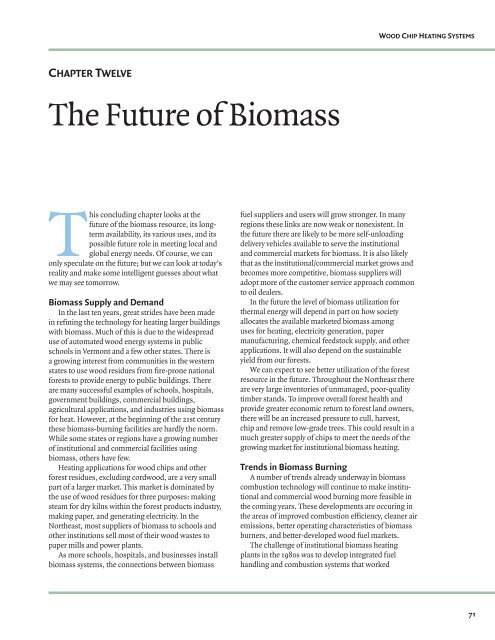Wood-Chip Heating Systems - Biomass Energy Resource Center
Wood-Chip Heating Systems - Biomass Energy Resource Center
Wood-Chip Heating Systems - Biomass Energy Resource Center
Create successful ePaper yourself
Turn your PDF publications into a flip-book with our unique Google optimized e-Paper software.
CHAPTER TWELVE<br />
The Future of <strong>Biomass</strong><br />
This concluding chapter looks at the<br />
future of the biomass resource, its longterm<br />
availability, its various uses, and its<br />
possible future role in meeting local and<br />
global energy needs. Of course, we can<br />
only speculate on the future; but we can look at today’s<br />
reality and make some intelligent guesses about what<br />
we may see tomorrow.<br />
<strong>Biomass</strong> Supply and Demand<br />
In the last ten years, great strides have been made<br />
in refi ning the technology for heating larger buildings<br />
with biomass. Much of this is due to the widespread<br />
use of automated wood energy systems in public<br />
schools in Vermont and a few other states. There is<br />
a growing interest from communities in the western<br />
states to use wood residues from fi re-prone national<br />
forests to provide energy to public buildings. There<br />
are many successful examples of schools, hospitals,<br />
government buildings, commercial buildings,<br />
agricultural applications, and industries using biomass<br />
for heat. However, at the beginning of the 21st century<br />
these biomass-burning facilities are hardly the norm.<br />
While some states or regions have a growing number<br />
of institutional and commercial facilities using<br />
biomass, others have few.<br />
<strong>Heating</strong> applications for wood chips and other<br />
forest residues, excluding cordwood, are a very small<br />
part of a larger market. This market is dominated by<br />
the use of wood residues for three purposes: making<br />
steam for dry kilns within the forest products industry,<br />
making paper, and generating electricity. In the<br />
Northeast, most suppliers of biomass to schools and<br />
other institutions sell most of their wood wastes to<br />
paper mills and power plants.<br />
As more schools, hospitals, and businesses install<br />
biomass systems, the connections between biomass<br />
fuel suppliers and users will grow stronger. In many<br />
regions these links are now weak or nonexistent. In<br />
the future there are likely to be more self-unloading<br />
delivery vehicles available to serve the institutional<br />
and commercial markets for biomass. It is also likely<br />
that as the institutional/commercial market grows and<br />
becomes more competitive, biomass suppliers will<br />
adopt more of the customer service approach common<br />
to oil dealers.<br />
In the future the level of biomass utilization for<br />
thermal energy will depend in part on how society<br />
allocates the available marketed biomass among<br />
uses for heating, electricity generation, paper<br />
manufacturing, chemical feedstock supply, and other<br />
applications. It will also depend on the sustainable<br />
yield from our forests.<br />
We can expect to see better utilization of the forest<br />
resource in the future. Throughout the Northeast there<br />
are very large inventories of unmanaged, poor-quality<br />
timber stands. To improve overall forest health and<br />
provide greater economic return to forest land owners,<br />
there will be an increased pressure to cull, harvest,<br />
chip and remove low-grade trees. This could result in a<br />
much greater supply of chips to meet the needs of the<br />
growing market for institutional biomass heating.<br />
Trends in <strong>Biomass</strong> Burning<br />
A number of trends already underway in biomass<br />
combustion technology will continue to make institutional<br />
and commercial wood burning more feasible in<br />
the coming years. These developments are occuring in<br />
the areas of improved combustion effi ciency, cleaner air<br />
emissions, better operating characteristics of biomass<br />
burners, and better-developed wood fuel markets.<br />
The challenge of institutional biomass heating<br />
plants in the 1980s was to develop integrated fuel<br />
handling and combustion systems that worked<br />
WOOD CHIP HEATING SYSTEMS<br />
71





